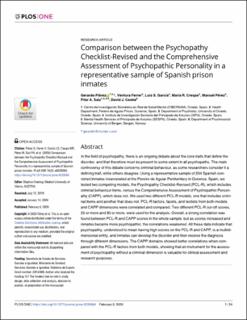| dc.description.abstract | In the field of psychopathy, there is an ongoing debate about the core traits that define the disorder, and that therefore must be present to some extent in all psychopaths. The main controversy of this debate concerns criminal behaviour, as some researchers consider it a defining trait, while others disagree. Using a representative sample of 204 Spanish convicted inmates incarcerated at the Pereiro de Aguiar Penitentiary in Ourense, Spain, we tested two competing models, the Psychopathy Checklist-Revised (PCL-R), which includes criminal behaviour items, versus the Comprehensive Assessment of Psychopathic Personality (CAPP), which does not. We used two different PCL-R models, one that includes criminal items and another that does not. PCL-R factors, facets, and testlets from both models and CAPP dimensions were correlated and compared. Two different PCL-R cut-off scores, 25 or more and 30 or more, were used for the analysis. Overall, a strong correlation was found between PCL-R and CAPP scores in the whole sample, but as scores increased and inmates became more psychopathic, the correlations weakened. All these data indicate that psychopathy, understood to mean having high scores on the PCL-R and CAPP, is a multidimensional entity, and inmates can develop the disorder and then receive the diagnosis through different dimensions. The CAPP domains showed better correlations when compared with the PCL-R factors from both models, showing that an instrument for the assessment of psychopathy without a criminal dimension is valuable for clinical assessment and research purposes. | en_US |

